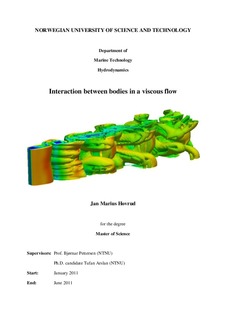| dc.contributor.advisor | Pettersen, Bjørnar | nb_NO |
| dc.contributor.advisor | Arslan, Tufan | nb_NO |
| dc.contributor.author | Hovrud, Jan Marius | nb_NO |
| dc.date.accessioned | 2014-12-19T12:06:57Z | |
| dc.date.available | 2014-12-19T12:06:57Z | |
| dc.date.created | 2012-03-02 | nb_NO |
| dc.date.issued | 2011 | nb_NO |
| dc.identifier | 507170 | nb_NO |
| dc.identifier.uri | http://hdl.handle.net/11250/238052 | |
| dc.description.abstract | Using the open-source CFD-solver OpenFOAM with a numerical scheme which is first order in time and second order in space, calculations of unsteady 3D flow around two cylinders in tandem arrangement at low Reynolds number (Re = 200) have been performed. Calculations have been done both with and without the assumption of symmetry with respect to y = 0; the latter being a crude model of a free surface. For the case of no symmetry aspect ratio, number of elements in spanwise direction and boundary condition on the front and back faces is discussed. The investigation has been done with special emphasis on the effect of separation distance and the flow in the gap between the cylinders. For the cases where symmetry about y = 0 is assumed, the influence of the boundary condition on this plane has also been investigated.
For the case of no symmetry it is found that the 3D effects inherent in a flow in infinite fluid at Re = 200 are inhibited for separation distances less than four diameters when an aspect ratio of six diameters is used. For S ≤ 0.5 and S ≥ 3 distinct low-frequency force pulsations are observed. Pulsations are suppressed for S = 1, 2. The differences and actual changeover between single and double vortex shedding flow schemes is discussed.
For the case of symmetry the flow is always 2D and the final solution is time-independent. Different boundary conditions on y = 0 are investigated. The influence of varying S/D is generally smaller than for the case without symmetry. Detached and reattached flow is studied and differences between cases with and without mirror condition are discussed. Recirculations zones below, behind and between the cylinders are studied.
The results are presented as integral quantities such as average and rms drag and lift coefficients, Strouhal number and pulsation periods, as well as more detailed quantities such as pressure, vorticity, velocity, velocity vectors and streamlines. | nb_NO |
| dc.language | eng | nb_NO |
| dc.publisher | Norges teknisk-naturvitenskapelige universitet, Fakultet for ingeniørvitenskap og teknologi, Institutt for marin teknikk | nb_NO |
| dc.title | Interaction between bodies in a viscous flow | nb_NO |
| dc.type | Master thesis | nb_NO |
| dc.contributor.department | Norges teknisk-naturvitenskapelige universitet, Fakultet for ingeniørvitenskap og teknologi, Institutt for marin teknikk | nb_NO |
